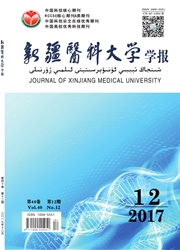

 中文摘要:
中文摘要:
目的探讨氟化物干预下骨钙素对脂类代谢的影响及其作用机制。方法采用大鼠饮水染毒法建立氟中毒模型,按照饮水中氟化钠浓度不同分为4个剂量组的实验组,包括:高剂量组(150 mg/L)、中剂量组(100mg/L)和低剂量组(50mg/L)。另设空白对照组(0mg/L),每组8只。每2周测量大鼠体质量。采用酶联免疫吸附(ELISA)法检测各组大鼠血清胆固醇(TC)、甘油三脂(TG)、脂联素(ADPN)、低密度脂蛋白(LDL)、骨钙素(BGP)的含量。结果染氟第4周起实验组大鼠体质量低于对照组(P〈0.05);染氟第8周起,高剂量组大鼠体质量低于低、中剂量组(P〈0.05);对照组血清TC、TG水平高于实验组(P〈0.05),实验组组间比较发现,高剂量组TC、TG水平均低于低剂量组(P〈0.05),中剂量组TG水平低于低剂量组(P〈0.05);对照组血清ADPN高于中剂量组和高剂量组(P〈0.05),中剂量组和高剂量组ADPN水平降低(P〈0.05);对照组血清LDL、BGP水平低于实验组(P〈0.05),高剂量组血清BGP增加(P〈0.05)。结论氟可能通过促进骨钙素的分泌参与调节脂类代谢。
 英文摘要:
英文摘要:
Objective To study the effect of osteocalcin on lipid metabolism under fluoride intervention and its possible mechanism.Methods A rat model of fluoride poisoning was established by drinking water.According to the concentration of sodium fluoride in drinking water,the animals were randomly divided into 4 groups,including the experimental group,high concentration group(150mg/L),medium concentration group(100mg/L),low concentration group(50mg/L)and blank control group(0mg/L)with each group having 8 rats.Body weight was measured every 2 weeks.Enzyme linked immunosorbent assay(ELISA)was used to determine the concentration of TC,TG,ADPN,LDL,BGP in serum.Results The body weight of the experimental group was observed to be significantly lower than that of the control group at the beginning the 4th week(P〈0.05).The body weight of the high dose group was found to be significantly lower than that of the low and middle dose groups at the beginning of 8th week(P〈0.05).The level of serum TC and TG in the control group was displayed to be pronouncedly higher than that in the experimental group(P〈0.05).the levels of TC and TG in the high dose group were observed to be remarkably lower than those in the low concentration group(P〈0.05).The level of TG in the middle dose group was exhibited to be markedly lower than that in the low concentration group(P〈0.05).Serum ADPN in the control group was shown to be significantly higher than that in the middle and high dose groups(P〈0.05).The levels of ADPN in the middle and high dose groups were presented to be significantly lower than that in control group(P〈0.05).The levels of serum LDL and BGP in the control group were shown to be significantly lower than those in the experimental group(P〈0.05).There was a significant increase in serum BGP in the high dose group(P〈0.05).Conclusion Fluoride may regulate lipid metabolism by promoting the secretion of osteocalcin.
 同期刊论文项目
同期刊论文项目
 同项目期刊论文
同项目期刊论文
 期刊信息
期刊信息
